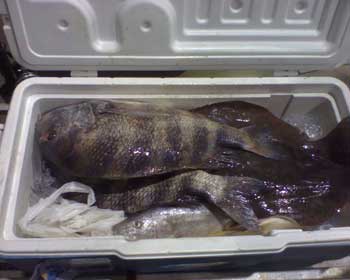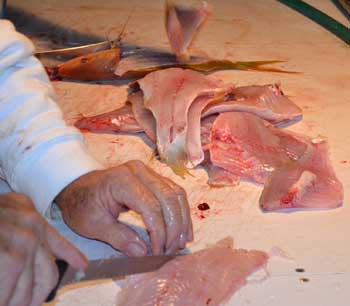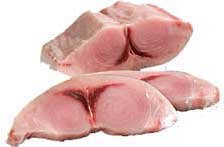Keeping Your Fish Catch

Courtesy of GaffLife.com
Note: Snook has closed seasons, please check regulations
The satisfaction of catching a fish and serving it for dinner is one of the most rewarding aspects of fishing.
You can't get any fresher than fish straight out of the water, never frozen, it just tastes great!
Be Prepared Before You "Go Fishing"
How you handle fish in the field will determine how tasty and safe they are to eat. Fish meat is very delicate and if not properly handled it will lose taste and texture very quickly and can spoil in a very short period of time.
Proper handling of fish is the key to good eating; it must be kept fresh from the water to the frying pan!
Immediately after a fish dies the meat begins to deteriorate. Heat is your worst enemy. Florida has year-round warm water, hot sun, and warm air temperatures which presents a challenge in keeping your fish fresh.
So, before you venture out to go fishing you should decide on how you are going to keep your catch fresh.
Keeping the Fish Alive

Photo courtesy of GAFFLife.com
The best way to ensure fresh meat is to keep the fish alive. Regularly checking on their well being helps to ensure they stay alive, but they will often perish despite our best efforts. If the fish perishes, remove them and immediately place them on ice. Here are your options for keeping fresh caught fish alive:
- Freshwater Fish
- Aerated live wells - put fish in the live well and change the water regularly especially if the fish is large or the well overcrowded
- Stringers - insert the stringer through the fleshy part of the lower jaw (never the mouth or gills) and put the stringer in the water
- Fish baskets - put the fish in the basket and lower into the water
- Saltwater Fish
- Cooler full of ice - immediately place fish on top of the ice, or pack ice around them. Icing quickly chills the fish and can be stored for several days. It is advised to keep the cooler drained of all the water from melting ice; fish floating in water adversely affects the texture and the flavor of the meat & begins the spoilage process.
- Aerated live wells - put fish in the live well and change the water regularly especially if the fish is large or the well overcrowded

Cleaning Fish

Photo Courtesy of Last Mango Sportfishing Charters
Ready to clean the fish? First you need a very sharp fillet knife, a fish cleaning table or large cutting board, a scaler or fliers, and gloves (optional). A knife as sharp as a razor makes quick work of filleting; dull knives leave you sawing at the meat and make messy fillets. Gloves help to hold the fish in place as you fillet so you don't slip and cut your self but are not required.
If you fish is still alive, please do the humane thing and terminate the fish by taking a blunt object like a hammer and make several blows to the top of the fish's head.
Fish cleaning stations or tables are great if you catch & process a lot of fish. All anglers with docks should have a fish cleaning table where you can clean your fish and chum the water at the same time, it's a lot less mess doing it on the dock. If you don't have a fish cleaning table, why not make one? The location of your cleaning station should be near a water source so you can hose down the mess after cleaning your fish. In this video you can learn how to make a deluxe fish cleaning station for a fun weekend project. It is great having one this nice but a simple 2 foot wide table works just fine too.

To clean the fish, place it on a flat, rough surface such as a piece of wood or a cutting board that will keep the fish from sliding around while cleaning. Use one of the techniques described in the following section to clean the fish.
Cleaning Techniques
Field Dressing
Field Dressing is commonly used by wading fisherman who cannot drag coolers to their fishing spot, they put the dressed fish in a Creel Basket. It is also used by saltwater anglers to keep their catch fresh longer and freeze faster, especially during the hot summer months when fish can spoil fast.
First slit the fish up the belly and remove the entrails and gills. Also scrape the kidney from along the backbone, it looks like a clot of blood. Now rinse the fish with water, wrap it in damp rags and place it in an insulated storage pack or cooler.
![]()
Warning! Do not fillet your fish while fishing from a boat then bag and ice the meat, it is illegal in Florida, you must return to shore with the fish whole. Field Dressing is allowed.
Filleting

Cutting the meat off the fish into fillets is the most common way to clean a fish. Please visit our webpage on How to Fillet a Fish.
Dressing
Dressing or cleaning a fish is done by removing the entrails, head, & fins keeping the skeleton remains with the meat. After cooking the meat simply flakes off the bones and the skin slips easily off. Fish with small scales like Trout are usually dressed whole. Fish that are difficult to fillet like Sheepshead, who have large scales, are scaled then dressed whole.
To dress the fish first remove the entrails then cut off the head. Next remove the blood vain located near the backbone. Now remove the fins and cut off the tail (caudal fin). Wash and cook whole.
Scaling
Scaling is removing the scales from the skin of the fish and is done before a fish is dressed. Many small or medium size fish like Sheepshead, Bluegill, Crappie, and Croaker are scaled, then dressed & served whole.
Use a scaling tool, start from the tail working words the head scrapping the scales off the fish.
Skinning

Skinning is a method of removing the skin from whole fish during the dressing process. It too is usually done before the fish is dressed. Skinning is usually associated with fish that have skin with no scales, like catfish or eel. The skin is basically peeled away from the meat before the fish is dressed.
To skin the fish, first make a cut behind the head and pectoral fin around the fish. Using pliers, pull the skin from the head to the tail. Now you are ready to dress the fish (see Dressing above).
Steaking
 Steaking means to cut the fish into steaks. Steaking is used primarily for large fish like Salmon, Tuna, Swordfish, big Stripers, Amberjack, Mackerel, and Shark where it would be impractical to leave the fish whole or fillet it.
Steaking means to cut the fish into steaks. Steaking is used primarily for large fish like Salmon, Tuna, Swordfish, big Stripers, Amberjack, Mackerel, and Shark where it would be impractical to leave the fish whole or fillet it.
To steak a fish you must first scale or skin and dress it, then working from the tail section toward the head, cut down through the backbone at intervals of about an inch creating the steaks.
Julia Child on Fish Cleaning
This video is a hoot! It was made in the early 1970's and shows many ways to clean and dress fish, some we never heard of before. There are segments filmed in France showing how to fillet sole, trout and mackerel.
Storage of Cleaned Fish


It is important to store your dressed fish properly, so determine beforehand when you plan to cook the fish.
If you plan to eat the fish in a couple of days, you can store it in the refrigerator. First pat down the fish with a towel to remove excess moisture then place in a plastic bag or container, and put in the refrigerator.
For longer than 3 day, you must freeze the fish which will last for months in the freezer using one of two methods:
- Remove excess moisture by patting down with a towel, place the fish in plastic wrap or aluminum foil, then in a layer of freezer paper.
- Place the fish in a plastic container, fill with water, cover and freeze.
It is important to keep the fish from coming in contact with air while freezing. To thaw, place the freezer container in the refrigerator overnight or unwrapped the fish and place in water.
For more information, visit Florida Sea Grant's Article Don't Let Your Catch Spoil the Day (scroll down on the page)
![]() CONSUMPTION ADVISORY: Relatively low levels of mercury in Largemouth Bass have been found to occur in Lake Okeechobee and in canals throughout southwest Florida. All individuals should follow Department of Health (DOH) guidelines. Florida Fish Eating Advisories Saltwater species also have warnings on page 27.
CONSUMPTION ADVISORY: Relatively low levels of mercury in Largemouth Bass have been found to occur in Lake Okeechobee and in canals throughout southwest Florida. All individuals should follow Department of Health (DOH) guidelines. Florida Fish Eating Advisories Saltwater species also have warnings on page 27.









